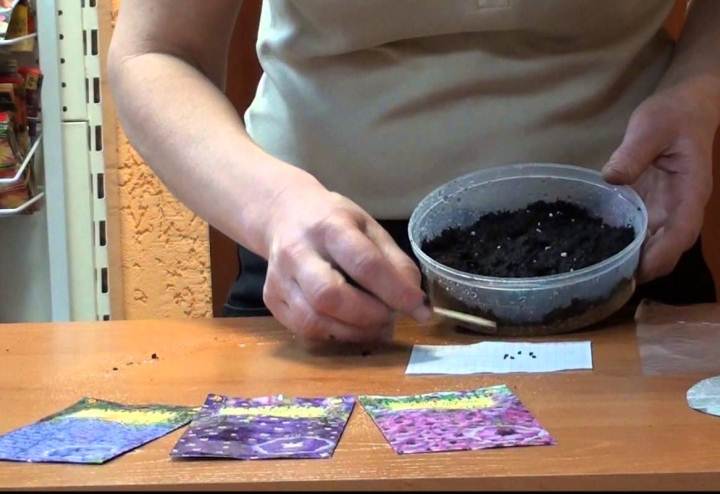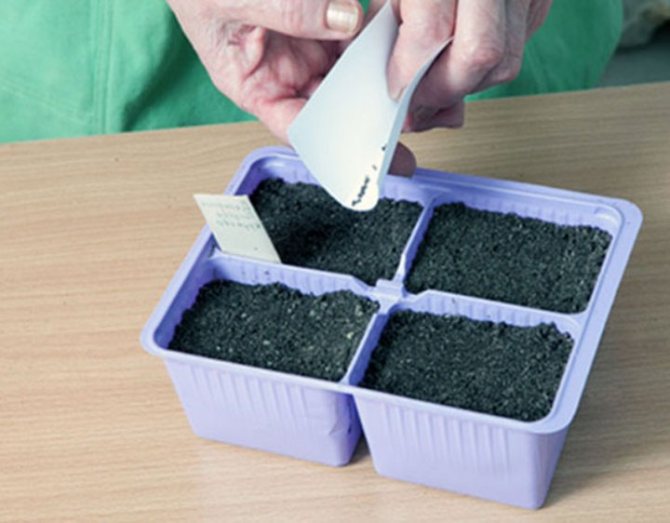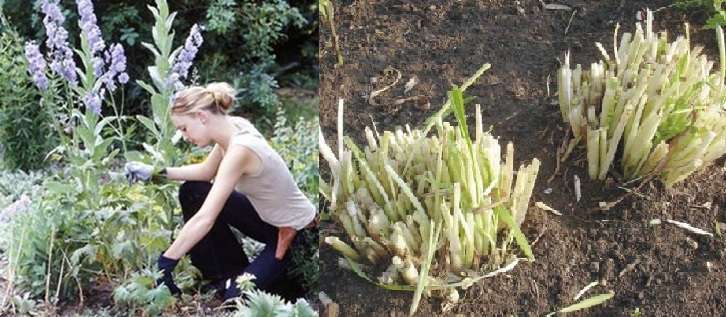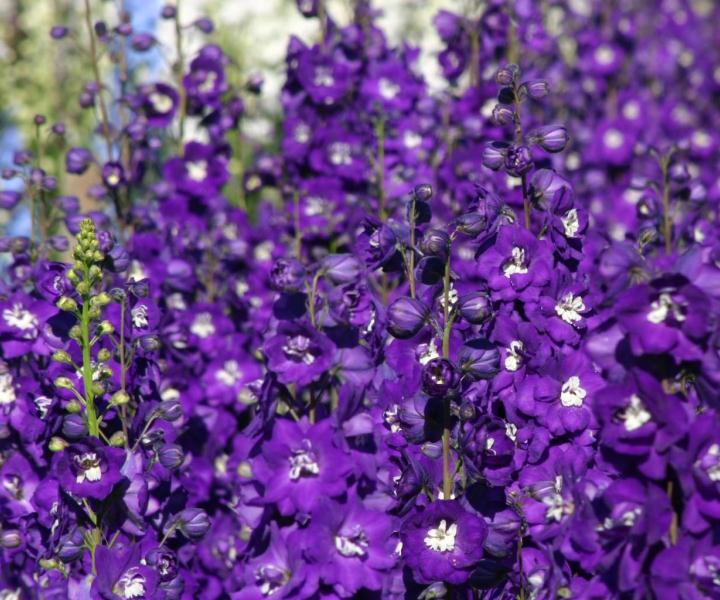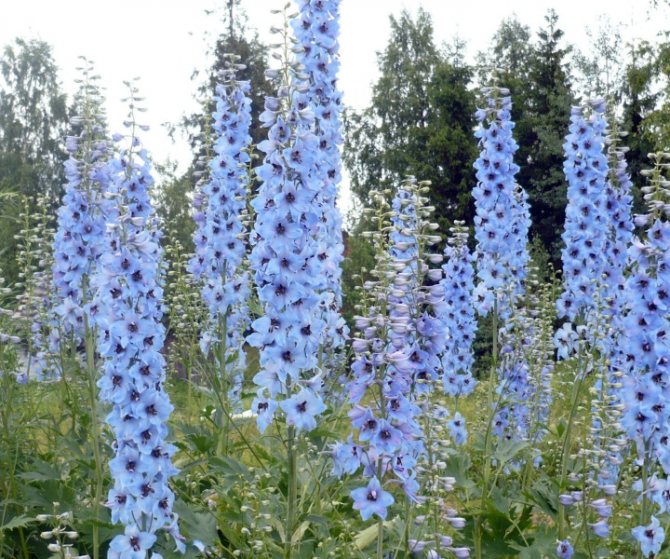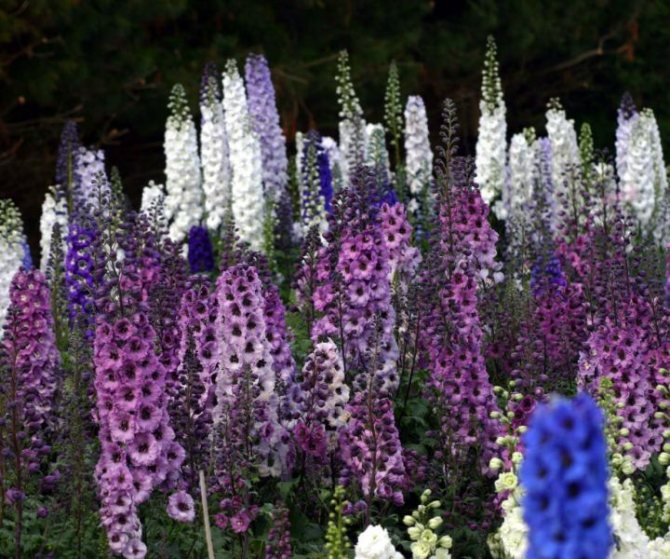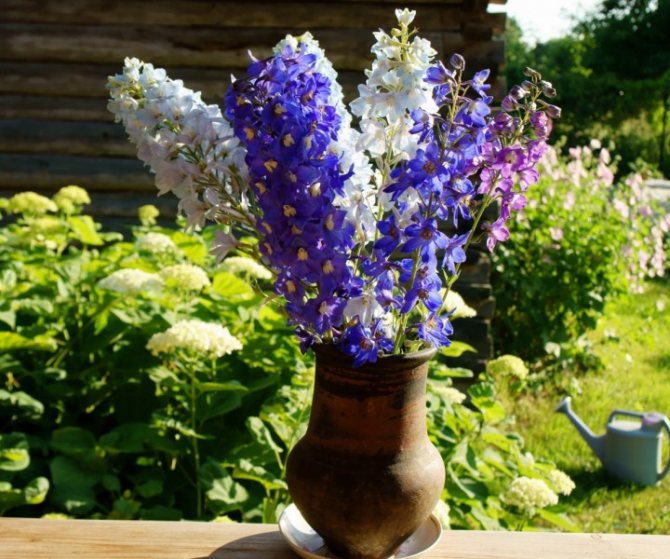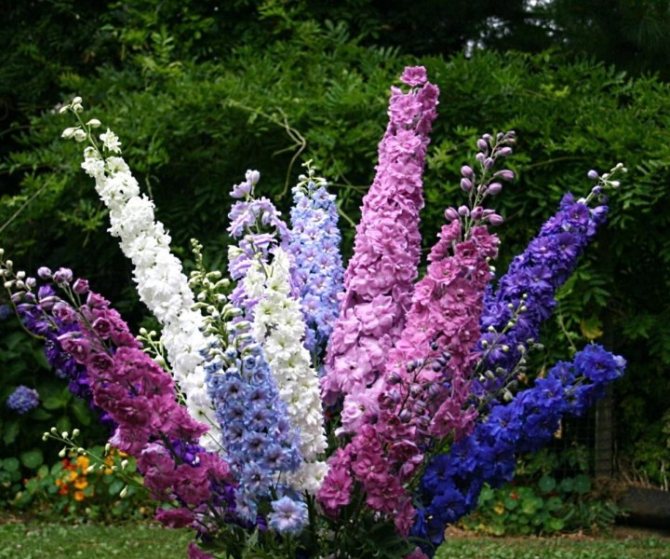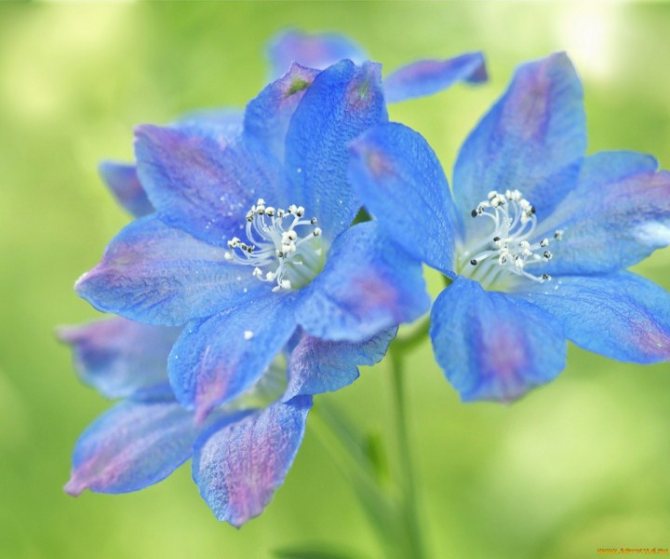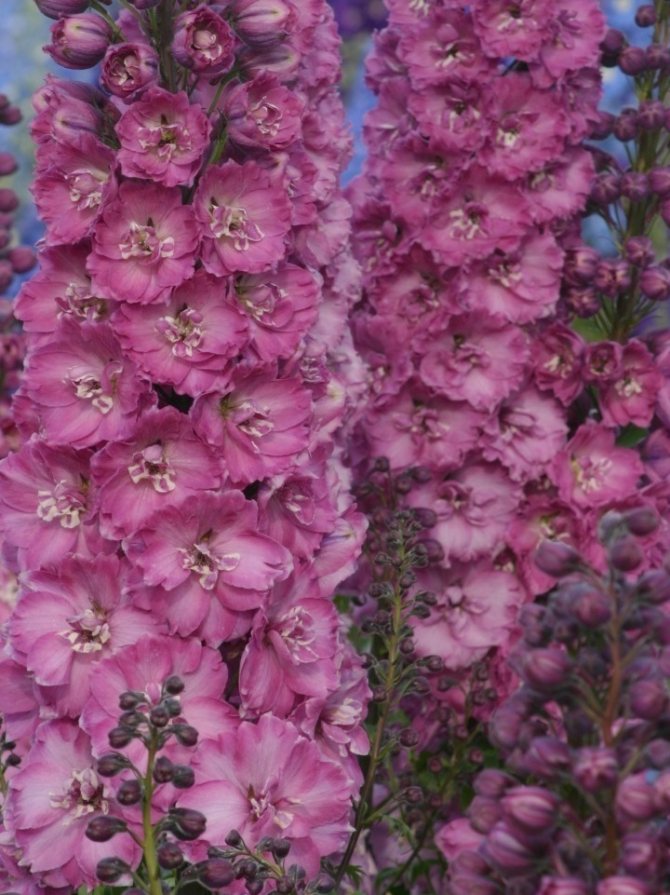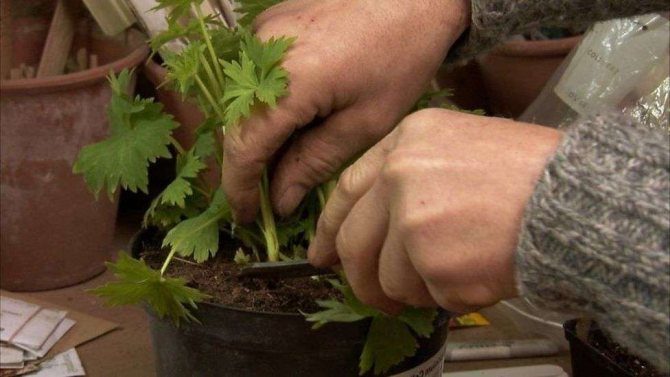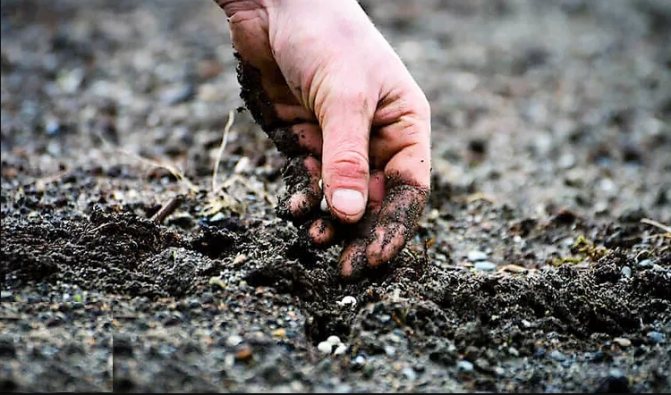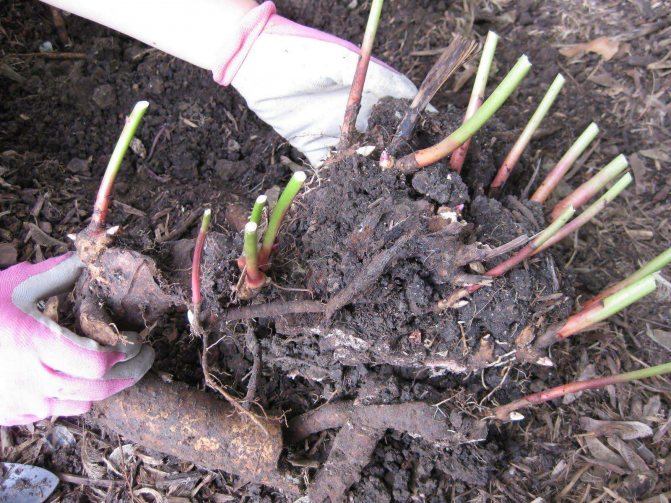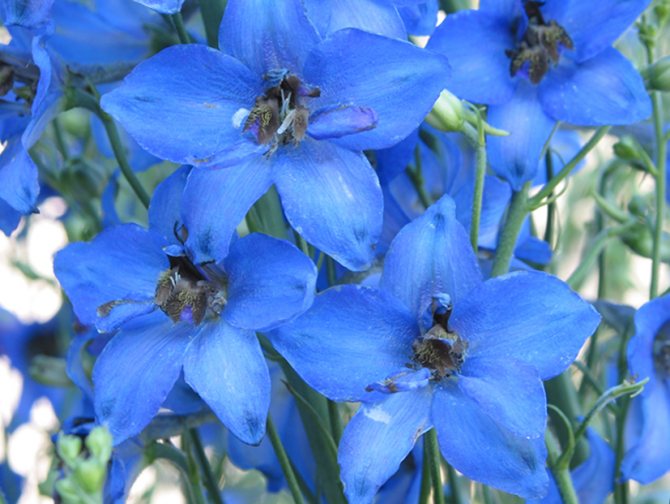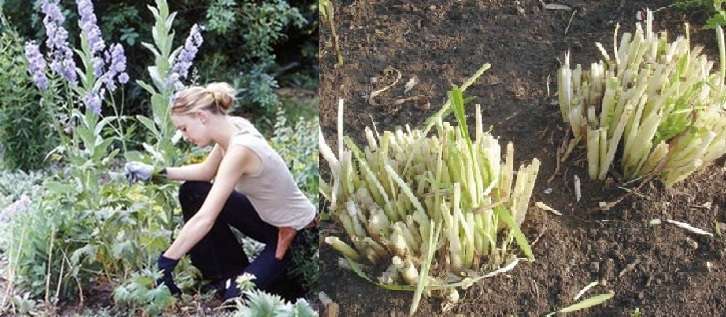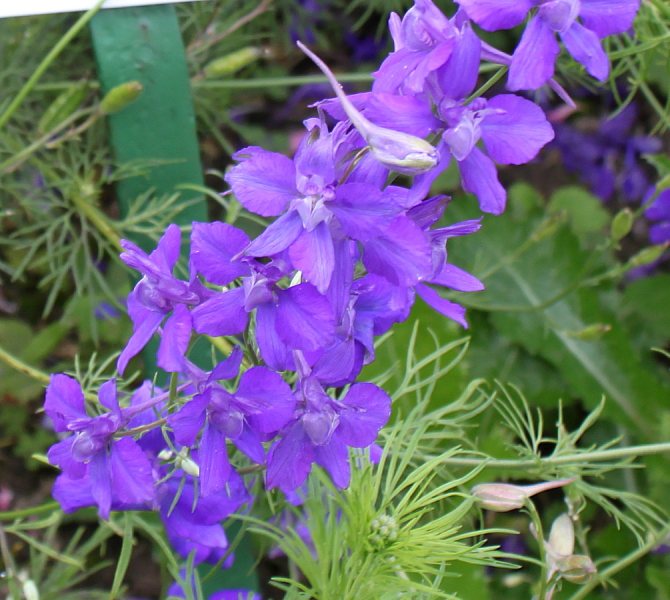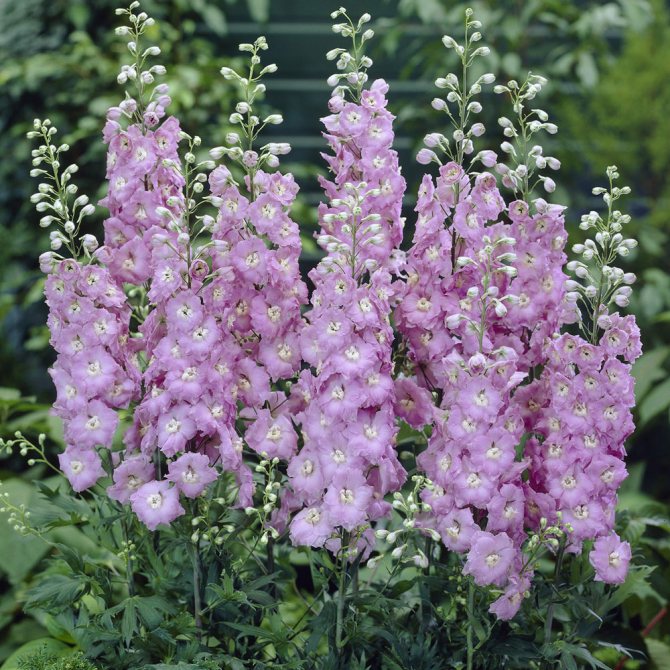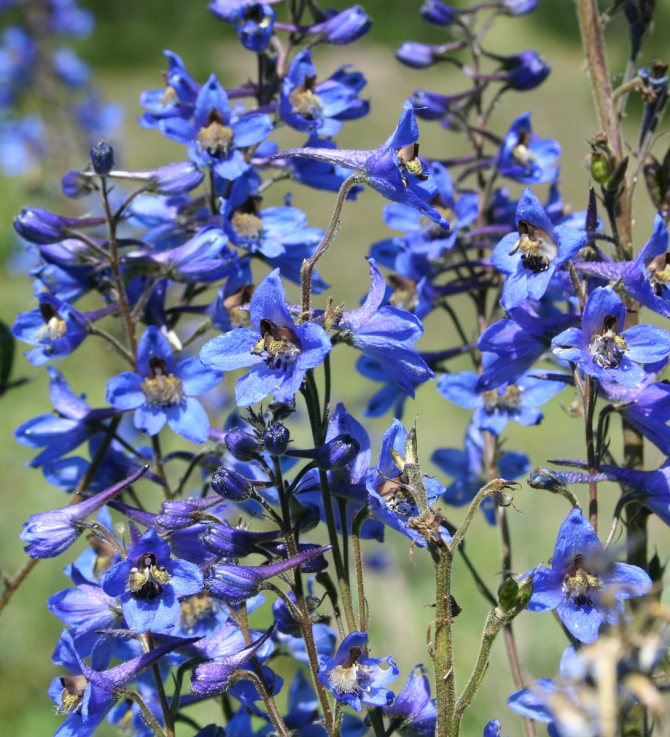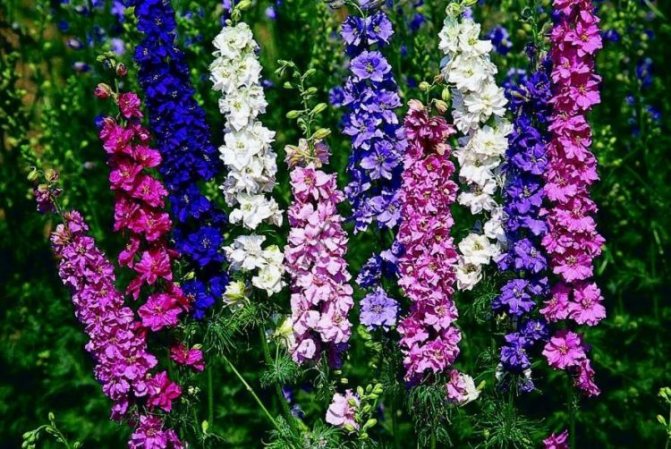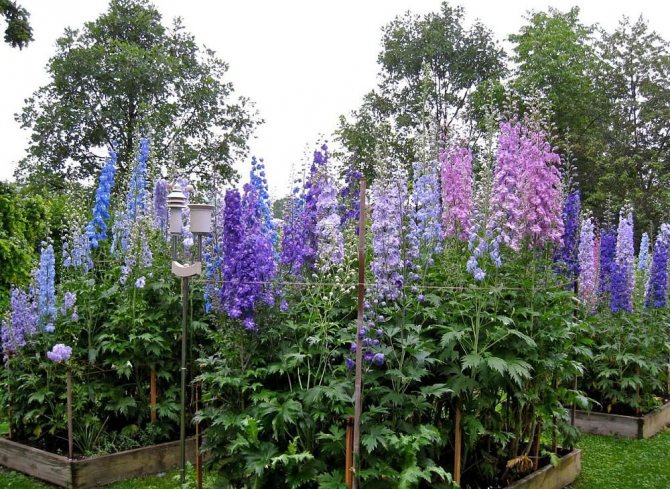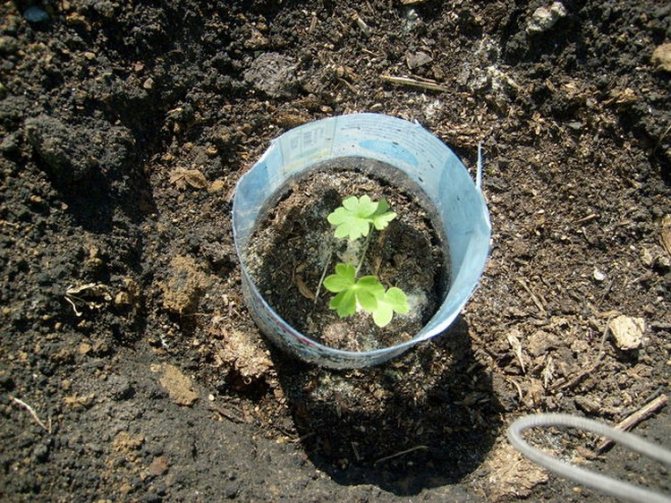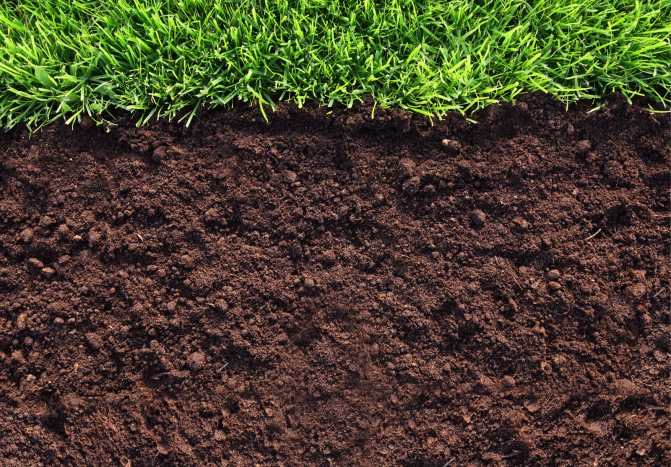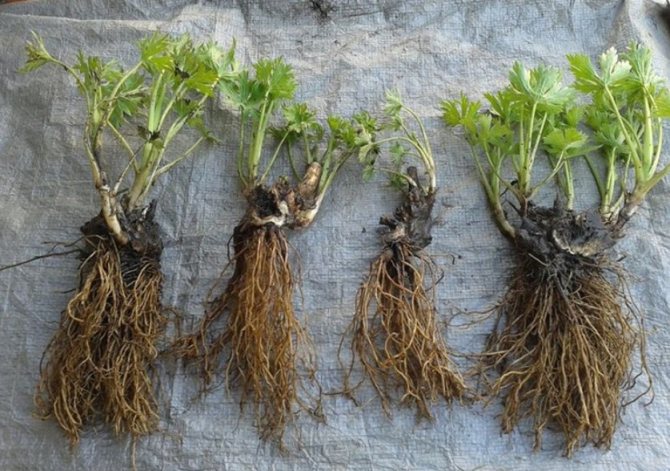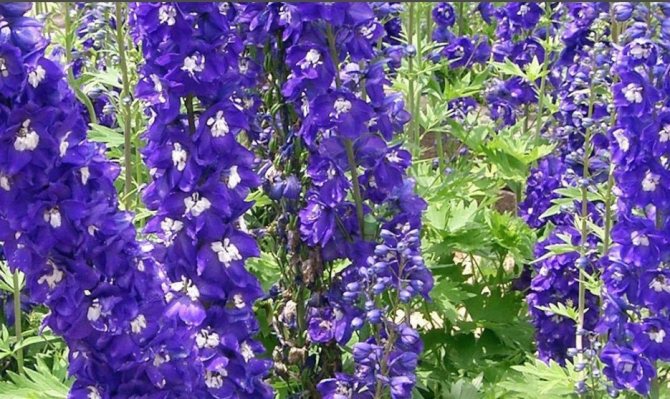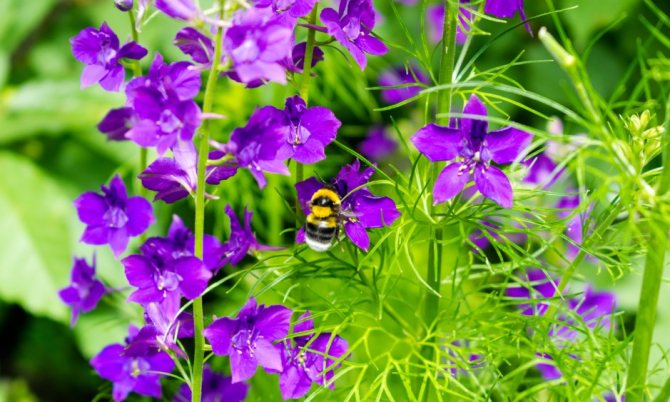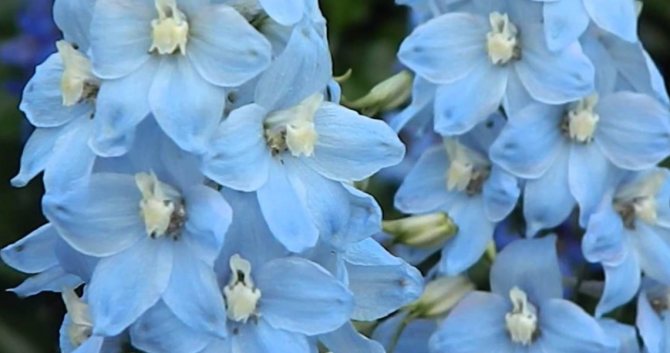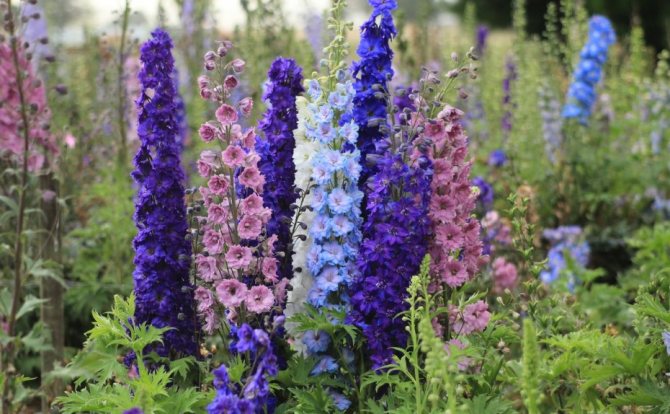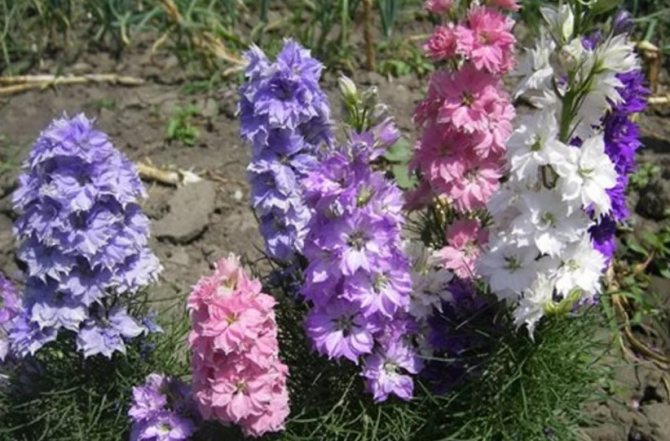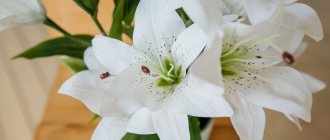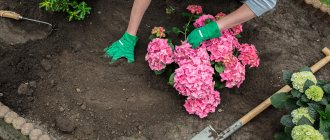The article describes the transplant of a delphinium, its description, all the features of cultivation, a guide to protection.
Delphinium belongs to the representatives of the buttercup family and is characterized as a whole genus of herbaceous annuals and perennials. Today there are about 450 varieties of this beautiful flower. In the people, this plant is most often called spur, or larkspur. This plant is considered quite capricious and demanding, it is quite difficult to grow it, and this flower does not tolerate transplants. But do not get scared quickly, caring for this plant is scary only from the outside. In this article, we will consider all the methods of reproduction of this gorgeous flower and the features of caring for it, as well as all the subtleties associated with plant transplantation.
Features of growing delphinium
Delphiniums grow up to one and a half meters tall and have a hollow stem. Even a slight breeze can break fragile stems. Too hot sun causes discoloration of flowers. This determines the choice of a place for planting them in the garden.
The plant prefers moderate watering and neutral soil. It is better to water less often, but abundantly. For good flowering, he needs top dressing three times per season.
Pruning is an indispensable element of delphinium care. He also requires a mandatory garter to the support in order to avoid breaking the high stem. The first garter must be done when the flower reaches 50-70 centimeters in height.
Important! The garter to the support must be done as the plant grows every 50 centimeters. It is better to tie it up with a strip of soft cloth so as not to pinch the stem.
Short description
A delphinium from the buttercup family is otherwise called a spur. There are both annual and perennial varieties. Florists love the plant for its very beautiful flowering and increased endurance. Delphinium grows well even in dark places, painlessly tolerates light frosts. However, the cultivation of this culture is laborious, therefore, it is rarely possible to meet it in gardens, in flower beds.
Important! Delphinium is a herb in which all parts are poisonous. Once in the human body, the toxin inhibits the central nervous system, disrupts the work of the cardiovascular system and the gastrointestinal tract. All actions for the care of this exotic flower are recommended to be carried out in special protective gloves!
Planting a delphinium in the ground
When planting a delphinium in open ground, it is necessary to take into account some subtleties that will help the plant to root well and then give good flowering and growth.
Planting methods
Landing can be done in three ways:
- Seeds
- Cuttings
- By dividing the bush.
Each of these methods has its own characteristics and difficulties. The main requirements to be met when landing are as follows:
- Choose a landing site in advance, taking into account the windiness and illumination.
- In the fall, prepare the soil in this place. It needs to be dug up, weeds removed as much as possible and fertilized with organic matter.
- In the spring, dig up this place again and apply fertilizers, this time mineral.
- Prepare holes 40x40 centimeters in size and up to 50 centimeters deep, spaced at least 50 centimeters apart.
- Pour drainage at the bottom of the hole.
- When planting, do not cover the root collar with buds with earth.
Important! After planting, be sure to water the flower abundantly and continue this watering for about a week.
Optimal planting time
Both spring and autumn are suitable for planting, the main thing is that young seedlings are not threatened by frost. Most gardeners prefer spring planting.
Plant soil
Delphinium needs a neutral fertile loose soil. In addition, it is desirable to drain it well. Lime must be added to acidic soil (50 grams per 1 square meter). The clay soil will need to be mixed with sand, you can immediately add drainage in the form of clay shards or broken slate. It is good to add peat to sandy soil.
Planting in spring
Usually delphiniums are planted in the spring on a place prepared in the fall. Disembarkation is carried out when the last frosts have already ended, as a rule, by the end of April.
Planting in autumn
If you wish, you can plant a delphinium in the fall, preparing the land in the same way as for spring planting. The best time for autumn planting is late August or early September.
Preparation of materials
In order to grow seedlings, seeds and soil of a certain composition are required. Also, growth stimulants will not interfere, which will make the stratification process more successful.
Stratification
In order for plants to grow well-developed, luxurious flowers, it is recommended to properly prepare the seeds. For this:
- Prepare a disinfectant solution from potassium permanganate or fungicide (Fitosporin, Maxima) diluted with water according to the instructions in the instructions.
- Place the seeds in a cloth bag and immerse them in the working solution for 20 minutes.
- Remove, wash off the remaining disinfectant liquid under running water.
- Place on a small plate and soak in standing water. The liquid should not be too much, it is necessary to add 2-3 drops of a growth stimulator ("Zircon", "Epina").
- After one day, drain the liquid, and put the seed on a damp cloth in a thin layer.
- Roll the fabric into a roll and place in a plastic container.
- Place the container in the refrigerator and periodically add 10-20 ml of water to it. It should only cover the bottom of the fabric roll. If there is too much liquid, the seeds will rot.
- An alternative to water is wet moss, which is used to transfer fabric rolls with seeds, after which the material is placed in the refrigerator.
- Stratification lasts a week, and when the embryos hatch, move the workpiece to the windowsill and hold it under phytolamps for a couple of days.
- Plant the sprouted delphinium in an open area or in containers filled with fertile soil.
The described method is suitable for planting seedlings in February and is designed for growing at home.
Another way to prepare seeds:
- Soak seed in early spring and wrap in cheesecloth.
- Place in a plastic bag.
- Bury it in the ground.
- After 1-2 weeks, remove and plant in the ground.
The best time for this method is April, when the snow began to melt. The temperature can range from -5-10 to + 3-6 ° C.
Priming
Planting a perennial delphinium requires preliminary soil preparation. You need to take garden soil and mix with peat and humus in equal proportions. It is recommended to add a small amount of perlite to the mixture (0.5 cups per 5 liters of soil) to make the soil structure looser. It will also keep moisture in the soil.
Preliminary preparation of the soil includes not only the creation of a fertile substrate, but also its steaming for the purpose of disinfection. The procedure is carried out using a steam bath for one hour. Such soil will be completely safe for seed.
Features of delphinium care
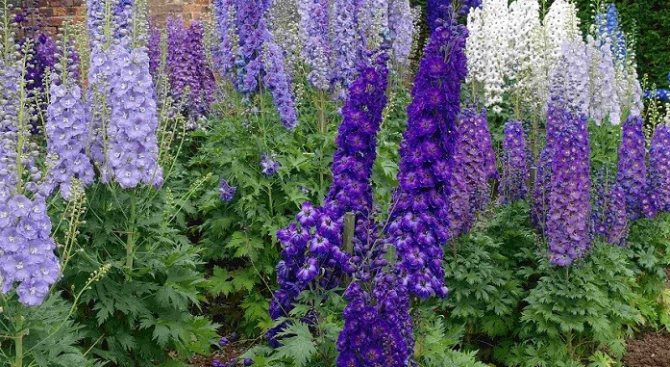
To get a beautiful, luxuriantly and fully blooming delphinium, care is needed for it.A plant left unattended will die or, at best, will not bloom.
Location for the plant
The choice of location is very important for a delphinium. The place should be well lit, but it is very desirable that it was in the shade for two or three hours a day.
This place should not be blown by the wind, because even a flower tied to a support can break.
Pay attention to which places in the garden are the first to form glades during the thaw. These places are contraindicated for landing a delphinium. The fact is that this plant does not have one large rhizome, but only a branched superficial root system.
It tolerates even severe frosts well, but at the slightest thaw, the roots begin to rot and rot.
Important! Avoid planting the delphinium near shrubs or trees, as they can take away nutrients from it.
Delphinium care after flowering
After the delphinium has faded, you need to cut off the main peduncle, unless you plan to pick the seeds. If the peduncle is cut low (8-10 centimeters), then it is necessary to take measures to ensure that the flower does not rot. It has a hollow stem and water can enter it, causing it to rot. Some gardeners use clay to seal the stem. You can simply bend the remaining stem towards the ground.
However, you can not cut the stem so low, but only remove about 30 centimeters. It is advisable to immediately remove all faded inflorescences.
When the flowering ends, it is necessary to feed the plant.
Delphinium care in autumn
In the fall, all faded inflorescences are cut off. The stem and leaves will gradually fade. As soon as the first frosts begin, the plant is cut off, leaving no more than 30 centimeters. Due to its frost resistance, an adult delphinium does not require any shelter for the winter, but it is better to cover young plants with foliage and spruce branches.
How to water properly
In a rainy summer, additional watering is not required for the delphinium. If the summer is too dry, the flower should be watered 1-2 times a week so that the ground does not dry out.
Only newly planted flowers require abundant watering within a week after planting.
The delphinium should be watered at the root so that water does not get on the leaves and inflorescences.
Also, abundant watering is needed during the formation of buds.
Preparing for the winter season
Matured plants that have survived the winter period further can survive the cold quite well. With regards to young plants, especially those transplanted in autumn, they require good frost protection. Therefore, they are insulated with needles, a good layer of fallen leaves, agrofibre, or an ordinary film that should be dug in so that the wind cannot carry it away. In this case, there should be at least 30 centimeters above the soil surface from the stems. And very young and small plants are covered with loose earth. It should be borne in mind that these perennial plants can die if in winter there is a frequent alternation of cold weather and thaw with an excess of moisture. Often, flower growers simply transplant them into separate containers and put them in the basement. But this does not diminish the likelihood of plant death.
Fertilizing and fertilizing a flower
Delphinium is fed three times during the season.
- In the spring (second half of April), you need to mix superphosphate (60 grams for an adult plant), ammonium nitrate (10 grams), potassium chloride (25 grams) and ammonium sulfate (35 grams). Fertilizer should be scattered around the bush and mixed with the soil to a depth of 5-6 centimeters. Sprinkle with peat on top.
- Budding period (early June). It is necessary to feed the flower with phosphorus-potassium fertilizer.
- After flowering at the end of August, I use the same fertilizers as in the spring.
Important! If there are difficulties with self-fertilization, you can use ready-made formulations for flowering plants.
Statistics
Copyright <2008-2018 Flower Bank. All rights to the material belong to the owner of the site.
When using materials from the encyclopedia, a clickable link to the source: Encyclopedia of flowers is required.
Currently, it is not difficult to acquire seeds or planting material (seedlings and seeds) of delphiniums. In garden centers and markets you can buy plants grown in pots or containers, and in seed shops and stalls you can buy beautiful seed bags. However, it should be borne in mind that with seed reproduction delphiniums they do not always convey their varietal characteristics.
Sometimes perennials are grown as annuals for one flowering season. In this case, they are first sown for seedlings in January-February, and in mid-May they are transplanted into a flower garden.
How to grow an annual delphinium
If most perennial delphiniums after sowing do not grow as beautiful as in the picture with seeds, then annuals and biennials propagate only by seeds.
By their nature, most delphiniums are cold-resistant plants. Seedlings tolerate return frosts well, so the sowing is carried out directly to the flower garden. In the spring they sow in late April - early May (then flowering begins at the end of June and lasts until the end of summer), you can sow before winter, after the arrival of stable frosts in November.
For sowing, a bright place is chosen, since delphiniums do not tolerate shading. It is desirable that there be protection from winds that break fragile plant stems. The delphinium does not make special demands on the soil, but it blooms better on air-and moisture-permeable, nutritious, non-acidic and non-soaking, moderately moist.
Seeds are sown sparsely in shallow grooves and sprinkled with a layer of soil about 0.5 cm. The crops are well watered. In dry spring, cover with burlap or dense non-woven material, the shelter is removed after germination, after about 10-15 days. When the seedlings grow up a little, they thin out, leaving 10-15 cm between them.
Sow delphiniums before winter possible only on light, structural, sandy loam or sandy areas. The fact is that the clay soil is strongly compacted during the winter and the seeds in it, as a rule, die. In autumn, they sow, when the ground freezes, the seeds are laid out in pre-prepared grooves. Sprinkle on top with dry earth or humus, non-acidic peat with a layer of about 1 cm. Before sowing, store the backfill in a greenhouse, a shed so that it does not freeze. To speed up flowering, you can grow annuals and biennials through seedlings. In early April, sow in pots, 2-4 seeds per hole, and in mid-May, transplant into a flower garden. They are planted, not thickening, after 15-20 cm. They do this carefully, trying not to damage the earthen lump, since delphiniums do not tolerate transplantation well. Flowering with early sowing for seedlings begins at the end of May and lasts until August.
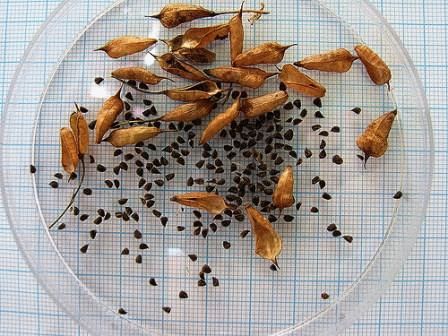

Delphinium pruning
Pruning a delphinium is a must for its growth and flowering. It is necessary for the plant to retain its decorative effect for a long time.
Delphinium grows rapidly and produces many young shoots. If they are not cut off, they take a lot of energy from the plant, which is very bad for the size and number of flowers.
Pruning methods
Already in the second year of the life of the bush, young shoots need to be cut out, leaving no more than five pieces of the strongest of them. You need to cut them when they grow to about 20 centimeters.
When the delphinium grows up to 30 centimeters, excess peduncles are removed from it. Only two are left in a young, annual plant and 4-6 in an adult. Only the most powerful of them remain.
It is better to thin out the central part of the bush at the delphinium.
After flowering, you can make a radical pruning of the plant, removing all the stems almost at the root.Then, after a short time, the delphinium will give new shoots, which will bloom for the second time in a season. In this case, the flowering, of course, will be weaker than the first, but it will still decorate the garden.
Important! The second flowering delphinium gives in a warmer climate. In moderate temperature conditions in the middle zone, it is better to prevent a second bloom, as it will weaken the plant, and this will affect its splendor in the next season.
Pruning for the winter
For the winter, all stems are cut off up to 30 centimeters and covered with clay on top.
Sowing
Spread the delphinium seeds evenly over the prepared soil. Sown flowers should be sprinkled on top with fertile soil, the layer height should not exceed 3 mm. After that, lightly compact the soil so that the seeds do not rise with water when watering. In conclusion, it is necessary to evenly spray the delphinium with warm water from a spray bottle.
Advice! When planting granular seeds, use tweezers for convenience. And in order not to forget in the future where which variety was sown, it is recommended to stick labels with the names of colors on the containers.
Given that the exotic giant grows better in the dark, it is advisable to cover the crops with a special covering material, black film or an ordinary plastic bag. It is also allowed to simply place the containers in the dark until the first shoots appear.
In order for the seeds to germinate well, it is not necessary to maintain a high temperature in the room, + 10 ° C is quite enough for them. You should not raise the temperature to +20: there is a high probability of ruining future seedlings. It is recommended to temper flowers to increase their level of resistance to negative environmental factors. The procedure involves the alternation of temperature conditions - cold / heat.
Seedlings should be expected after planting in 7-10 days. As soon as they appear, you will need to remove the covering material. After the appearance of real leaves, the delphinium must be dived.
Delphinium transplant
Delphinium does not like too frequent transplants. It is best to replant shrubs 4-6 years old. Some gardeners transplant once every 3-4 years.
Transplant methods
It is better to replant the old bush in the spring. You need to dig out the bushes that have already grown to 15 centimeters. With a sharp knife, it is divided into several parts, each having 2-3 shoots. The cut points are processed with charcoal.
The roots are cleaned from the ground and old deformed parts are removed on them. Then the delenki are planted in pots with a mixture of fertile soil, humus and sand. It is better to put the pots in the greenhouse for two weeks. And only after that, the shoots are transplanted into the ground to a new permanent place.
After transplanting, new plants need to be fed and watered well. Preparing a permanent site for the transplanted plant is the same as when planting.
Important! Even before transplanting into open soil, the delphinium can throw out a peduncle. It must be removed.
How to properly care for plants in the early days?
As soon as the first seedlings appear, you need to remove the cover - the plants need air. It is also worth monitoring the level of moisture in the soil - it should not be too wet, but not too dry.
If we talk about watering, then there is one important rule here - do not water the delphinium from above, because this will destroy the young seedlings, after such watering they will fall and will not rise. Therefore, they are watered only in a pallet - this method of planting will save the seedlings, and at the same time the required percentage of moisture will be guaranteed.
Plant propagation
It is easy to propagate a delphinium, this process is within the power of even a novice florist.
Reproduction methods
In total, there are several methods of reproduction - growing delphinium from seeds, cuttings and dividing the bush. The simplest one is propagation by seeds, the most laborious one is propagation by cuttings.
Reproduction of delphinium by seeds
Different varieties can be planted from seeds available in flower shops. You can also collect seeds from a plant.
After collection or after purchase (it is better to buy them in the fall), the seeds must be kept for several months in a cool place, preferably in the refrigerator.
They can be planted in March. For this, a container is prepared with a mixture of humus, fertile soil and sand. The soil must be moistened and grooved on it. Delphinium seeds are very small, so they do not need to be buried in the soil. You can simply scatter their grooves and sprinkle on top with a layer of earth a few millimeters.
After a month, the seedlings are thinned out at a distance of about 8 centimeters from each other.
Plants are planted in open ground in May.
Important! Reproduction of terry varieties by seeds will not give maternal traits in new plants.
Reproduction of delphinium by dividing the bush
At the end of April, when the bushes have grown by 15 centimeters after winter, they are dug up and divided into several parts with 2-3 shoots each.
Further, the procedure is the same as described in the section Delphinium Transplant.
Reproduction of delphinium by cuttings
Despite the laboriousness of the process, this method is very effective, it allows you to preserve the mother plant itself and its species characteristics.
It is better to propagate delphinium by cuttings taken from young plants. To do this, in spring, when the stems grow a little (up to about 15 centimeters), you need to cut the cuttings at the very root. For quick rooting, you can treat them with growth stimulants.
Cuttings are planted in loose fertile soil in a container that can be placed in a greenhouse. If the planting is done immediately on the bed, it is better to cover the cuttings with jars. In this case, the plants need to be regularly ventilated.
Cuttings need light shade and watering. After 14 days, they need to be fed with complex fertilizers.
Rooting of cuttings occurs by the end of summer, then they can be planted in a permanent place.
Best neighbors
These beautiful plants are often used as backgrounds in flower gardens. Lilies and phlox are good neighbors for them, they also feel good in the neighborhood with dahlias and roses. One has only to plant all these plants correctly so that they cannot interfere with the growth and development of each other, and also do not shade other plants. Of course, you can plant other flowers with these plants. You just need to take into account the fact that it is better to plant flowers similar to this plant for the care, requirements for the soil, in order to avoid the appearance of various unpleasant diseases.
Delphinium transplant
Problems, diseases and pests in the flower
Delphiniums can be affected by fungal diseases:
- Powdery mildew. Sign - the appearance on the leaves of a gray bloom. If left untreated, the leaves turn brown and die off. Prevention - avoid getting water on the leaves or trunk when watering. Treat with 1% sulphurous lime.
- Downy mildew. Sign - the appearance of yellow spots on the upper leaves and on the lower part of the leaf in the same place of gray bloom. First of all, you need to thin out the bush, and then treat it with 1% Bordeaux liquid.
- Rot of the root collar. Sign - yellowing of the leaves and the formation of mycelium of the fungus in the root zone. The plant is easily pulled out of the ground, as its root system will die. It is treated with a formalin solution - spraying and disinfecting the soil.
Viral infections:
- Astral jaundice. Signs - the leaves turn yellow, and the flowers acquire a greenish tint. First of all, it is necessary to destroy aphids as carriers of infection. Diseased plants are destroyed, the rest need to thoroughly loosen the soil.
- Ring spot or mosaic. Signs - the formation of yellow or brown spots on the leaves, drying and falling of the leaves. Slowdown in growth. It is not subject to treatment, the plant is destroyed.
Pests:
- Delphinium fly. Lays the larvae in buds. They eat the flower from the inside, so it quickly crumbles and does not produce seeds. It is necessary to sprinkle with hexachlorane during the period of bud formation
- Slugs. They eat the leaves. Thorough loosening of the soil and weeding is necessary.
Cuttings
Young shoots about 10 cm long are used as cuttings.
- The lower cut is treated with a root stimulator. For these purposes, an ordinary agave is suitable. In an adult aloe, the bottom leaf is torn off and kept in the refrigerator for 5 days.
- Next, the lower parts of the cuttings are moistened with aloe juice.
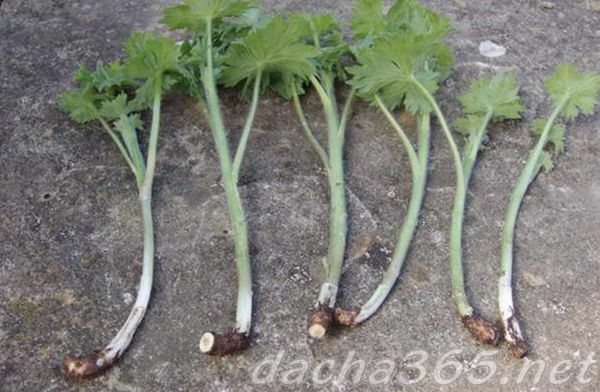

- Cuttings stick well-moistened sand or vermiculite. You can use Kornevin and similar agents.
- Containers with cuttings are covered with foil to maintain moisture.
- When the cuttings take root, they will put out new leaves.
- The grown seedlings are transplanted into open ground at the end of summer, so that they have time to adapt and take root before the cold snap.
Important! Delphiniums tolerate winter well in Central Russia, the main thing is to cover them with sawdust or dry peat.
When the plants grow up to 10-15 cm, they are fed with mullein solution. For 1 bush:
After loosening the soil and removing weeds, the flowers are mulched with peat or humus, making a layer of 3 cm.
When the plants grow up to 20-30 cm, they need to be thinned out. Choose 3-4 strong stems, and break off the rest or cut off at the surface of the soil. Thus, the inflorescences will become larger, and the bush will be better ventilated.
Trimmed cuttings with a heel can be rooted, as long as they are not hollow. The cut is treated with crushed tablets of heteroauxin and charcoal.
When the plants grow up to 40-50 cm, 3 supporting rods, 1.8-2 m high, are dug in near each bush. The shoots of the plant are tied to them with a soft rope so that it does not crash into the stem during a strong wind. When the shoot grows to 1–1.2 m, it is tied up again at a new height.
During the growth of the bushes, they need about 6 buckets of water. If the summer is hot and dry, then once a week each flower is watered with 20-30 liters of water.
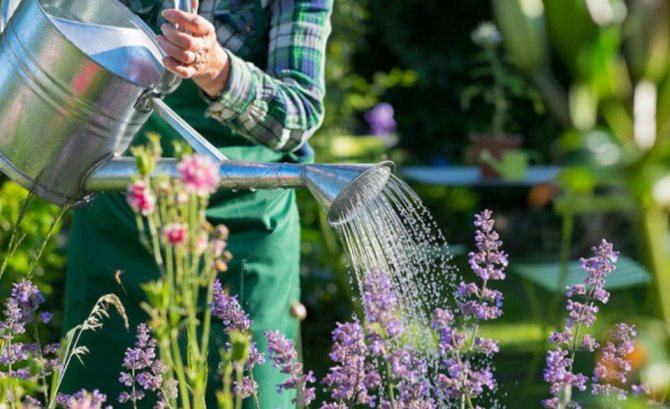

When the soil dries slightly, the top layer is loosened 3-5 cm in depth.
When forming inflorescences, the bushes are watered abundantly. So that areas with no flowers do not appear on the plants, the delphinium is fed with phosphorus-potassium fertilizer
20 g of superphosphate per 10 liters of water, 1 liter of solution is poured under each bush.
Popular species (varieties)
Princess Caroline
- A very beautiful variety with pink double flowers, growing up to 2 meters in height. Large flowers can be up to 10 centimeters in diameter.
Pink butterfly
Delicate, similar to butterflies with open wings, pink flowers and low growth of the bush (no more than 1 meter) make this variety especially in demand in landscape design.
Snow lace
An unusually spectacular delphinium variety with snow-white flowers with a dark eye. This variety has a very pleasant aroma during flowering.
Delphinium terry
Differs in long and lush flowering from May to August. Flowers have a wide variety of shades. Although in some places you can find delphiniums even black, red and yellow.
Annuals and perennials
All types of these plants will be effective - both perennial and annual. However, it is much more profitable to grow perennials, because having planted a delphinium once, then in the next few years you will not have to think about growing them.
This plant gained its popularity in the 19th century - at that time the first hybrids were bred, which attracted flower growers with their exquisite appearance. They exist now, but in a slightly improved form.
But the most standard varieties are considered:
- Barlow.
- Belladonna.
- Delphinium is beautiful.
The color palette of this plant is also attractive - about 700 different shades.
Variety of delphinium varieties
Delphiniums are divided not only into groups according to the timing of growth, but also according to geographic location. Moreover, the "migration" of crops is an inevitable process, because flower growers from all over the world conduct "experiments" with the cultivation of new varieties, share the seeds with their friends from other countries.
One of the "youngest" delphiniums is the New Zealand variety. Such plants differ in height - their "growth" reaches about 2.2-2.5 m, flowers are the largest and very elegant - double. This variety is resistant to diseases, frost, it is also very durable both in a flower bed and in the form of a bouquet.
This variety is especially popular with private gardeners, since the cultivation of such a crop is a pleasant and profitable business.
Another beautiful variety is Scottish delphiniums with dense inflorescences, a huge number of petals, of which there can be about 50. In slices, the Galahad delphinium looks especially good: large white flowers collected in ears - they are ideal as a gift.
Difficulties in growing a plant. Useful tips (Note to the flower grower)
Delphinium - a flower to care for is not easy, but you can avoid mistakes in growing it by following a few tips:
- Delphiniums treat organic fertilizers very well, in particular, manure. It can be scattered under bushes in spring and autumn;
- The plant needs constant weeding and loosening of the soil;
- For the prevention of fungal diseases, it is good to sprinkle the leaves with ash;
- It is better to collect seeds in dry warm weather from slightly unripe brown bolls.
Where is the best place to buy seed material
Only experienced gardeners and breeders know how to properly store the seeds of exotic plants. You should know that you cannot keep them at room temperature, as they lose their vitality. It is best to place the planting material in a refrigerator or special chambers in which the temperature does not exceed zero degrees.
Delphinium seeds sold in stores or markets, in most cases (60-80%) do not germinate. And the fault here is not the gardener who planted them in the wrong substrate or applied the wrong fertilizer - it's the seeds themselves. In non-specialized retail outlets, sellers do not adhere to the technology of storing exotic flowers. After packing the seeds in paper bags, they simply place them in a warm place. As a result, there are no shoots, the money spent disappears.
A good option would be if delphinium seeds are purchased from people who breed them. It is necessary to cut off brown bolls from healthy and sufficiently developed bushes. A pronounced dark brown color indicates the maturity of the planting material. You can rip off the boxes, which have just begun to show brown spots, but then they need to be put in a cool room and kept until the shade completely changes.
From the ripe boxes, the seeds must be carefully poured onto a sheet of paper, dried and placed in a glass container. The jar must be placed in the refrigerator or freezer, or taken out to the veranda / balcony. Thus, the seeds can be stored for 15 years. Then you need to "wake up" the delphinium, ie. carry out stratification.
Watering
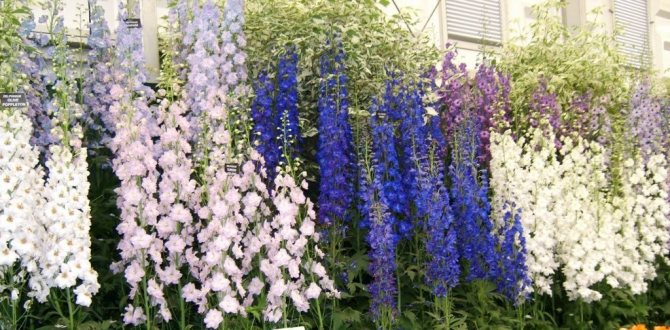

This larkspur loves to be watered abundantly, it does not tolerate dry times. The soil should not dry out. But still, the root collar needs protection from decay if the root collar is damaged by excessive moisture. For this reason, the soil must be well drained.
The thaw is most dangerous for a flower, after a snowy winter, when an excess of melt water can destroy the root system of the burgundy, from which the plant will die.
For this reason, you need to be very careful when choosing a place where the flower will be planted.It is necessary to choose a place that dries out quickly enough with the onset of spring, without forming stagnant water.
Stem support
In an early stage, before too much growth occurs, pegs need to be stuck in to increase the stability of the stems. You can use bamboo, metal and other rods. Strong wind and rain can damage delphiniums, after which they rarely recover. Don't forget to remove the pegs when autumn comes, however. Yellowing of the foliage will indicate that the stakes removal process can begin.
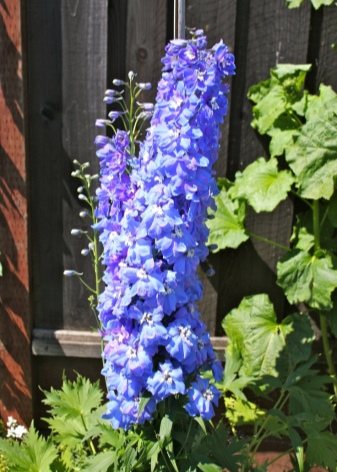

How to cut flowers into bouquets
These wonderful plants began to grow in our country not so long ago. At the permanent flower exhibition in Kazan, they, being presented for the first time, once made a real sensation. Today, in yards and gardens, you can mainly see the New Zealand delphinium or cultural (complex hybrid). In bouquets, his flowers look just great. Cut inflorescences to prolong the preservation need to be turned over and water is poured into the hollow trunk. To prevent it from spilling out, the green "tube" is corked with a cotton swab. Delphiniums look best in narrow tall vases. These flowers will keep their freshness for a long time - about 10 days.
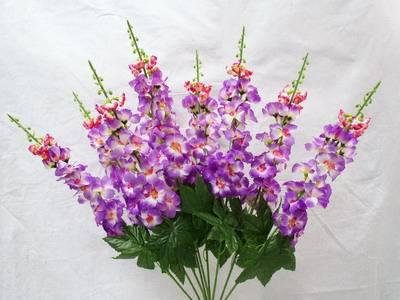

Cooking the garden
In October, before sowing seeds, the soil in the garden or flower bed is dug up with the addition of fertilizers. Introduce 3 kg of humus and peat, 1 tablespoon of superphosphate, potassium sulfate and urea. You can also add river sand and 300 g of ash. The dosage is given for 1 square meter of soil. The soil is dug up to 25-30 cm with fertilization, leveled with a rake and grooves are made 2 cm deep. After that, the soil is covered with lutrasil and left until November, before the first frosts.
After the frost touches the ground, the lutrasil is removed. Dry aster seeds are lowered into the frozen grooves, and then sprinkled with soil by 2 cm.
Which soil to choose or prepare
For this plant, it is better to choose a place where the soil is slightly acidic, and even better neutral. A good drainage layer and good fertility are also required. The best will be loose loam, where peat and compost are mixed before planting.
If the soil in the garden is acidic, and you really want to grow a spur, you can use slaked lime. It needs to be scattered about 150 g per square meter in autumn, adding about 7 kg of peat and manure, after which the site must be dug up and left for the winter. You can throw some dolomite flour into the hole.
In springtime, as soon as the snow melts, the soil needs to be loosened and fed again. This has already been written above. And only then can the delphinium be planted in the prepared place. For this, a hole is prepared about 0.5 meters deep. The soil dug from the hole must be mixed with peat in half and covered with what will fit. After that, they allow the soil to settle for several days and only then plant a young plant, adding a little sand to the hole, which was again dug out for planting.
How to sow aster?
Now you can start planting:
- draw shallow grooves directly on top of the ash with a wooden stick or branch (you do not need to mix the ash with the soil);
- put seeds in prepared beds, not very thickly;
- cover with earth.
If sowing is not carried out in frozen soil, it will be better to fill the grooves with a purchased loose substrate. When using ordinary soil, a crust forms in the beds, through which the seedlings may not break through.
Sowing under winter will allow you to get stronger plants that are resistant not only to diseases, but also to weather conditions. In addition, flowering occurs earlier in such crops.
Video instruction for winter sowing of asters
After flowering
Shoots are cut when the leaves of the faded plant are dry. Leave only 30–40 cm from the ground. The top is coated with clay so that moisture does not get into the hollow shoots and cause rotting of the root system.
Delphinium is a frost-resistant plant even in the first year of life. If in winter there is little snow in the region and the temperature is below freezing, the plants should be covered with straw or spruce branches. Delphinium can die only with a sharp change in temperature due to decay.
Advice! As a preventive measure for stagnant water, it is initially recommended to pour 0.5 buckets of sand at the bottom of the planting pit.
Seat selection
Flowers enjoy space and sunshine, so an outdoor area provides a number of benefits. However, strong winds can cause irreparable damage to them, so it may be necessary to use a windbreak.
All walls (temporarily erected) or a fence are fine.
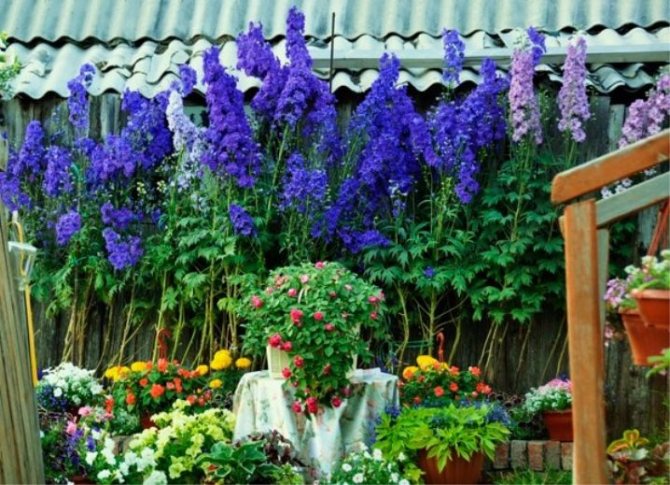

The combination of delphinium with other plants
The traditional partner for the delphinium is the foxglove. The beauty of this duo is celebrated in country style and all the nostalgic garden designs. More massive, elongated foxglove inflorescences set off the delicately "cut" delphinium candles, emphasizing the beautiful structure of each flower. And the classic combination of blue and pink colors seems to have been created for flower beds. Self-seeding digitalis gives this combination chaos, lightness, naturalness, bringing the lines and contours of the flower garden closer to the natural images of the wild. The duet of foxglove and delphinium is suitable for fairly large flower beds, because both of these plants do not belong to the squat group. You can plant such partners not only in a flower bed, but also in those parts of the garden that you want to fill with flowering “thickets”.
But for a romantic garden or a country-style flower garden decorated in a country style, it is better to choose an unexpected combination of delphinium and mallow, which is correctly called a stock-rose. Very often, such a charming village duo is planted near fences and fences, in mixborders adjacent to a wooden wattle fence. A taller and slender mallow originally sets off a more graceful and delicate delphinium, and bright colors create the necessary variegated diversity. If the site is windy enough, then it is better to install supports for both plants.
Delphinium is often used to "highlight" flower beds: towering above the total mass of plants in a flower bed, magnificent elongated inflorescences seem to illuminate the flower bed from above. The blue-eyed, candle-shaped handsome man looks great in this role next to the bright colors of lupins - rich orange and pink - playing in contrasts with more squat plants and optically making the flower bed more voluminous, light and deep. But in the design of flower beds, you can achieve the same highlighting effect with the help of another duet - a cheerful delphinium and a mallow darker in color. Rising above the delphinium, the mallow of very dark colors (for example, burgundy or purple) with its large flowers emphasizes the elegance of the lighter delphinium, visually increasing the size of the flower beds and creating the effect not of an external (as in the first case), but of an internal glow.
We sow asters before winter
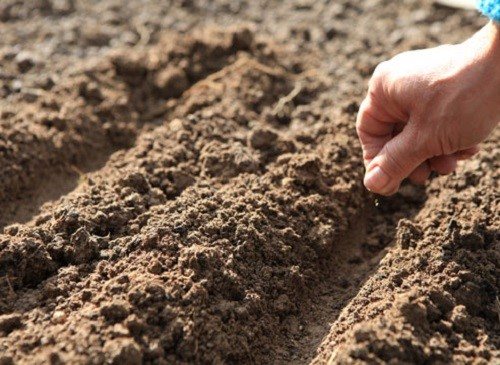

Despite the fact that the main time for sowing seeds is spring, most crops, including asters, can be sown before winter. Sowing in winter will help protect plants from most diseases and from their most important enemy, Fusarium, but for this it is necessary to start planting on time. After all, if you sow the seeds too early, during a warm autumn, they will quickly sprout, which means that the very first frosts will nullify all efforts, and the flowers will simply freeze, never waiting for not only spring, but also a real winter.
When to prune a delphinium in the fall?
The time for trimming the stems depends on the flowering period of the variety. It can range from 1 to 2 weeks. On average, the procedure falls at the end of September.
By this time, the warm weather outside has time to change to a steady cold. The pruning procedure is carried out in the morning. Better to choose a day without precipitation.
Other gardeners advise against pruning. Old shoots are easily removed in spring. If desired, a person can try two methods.
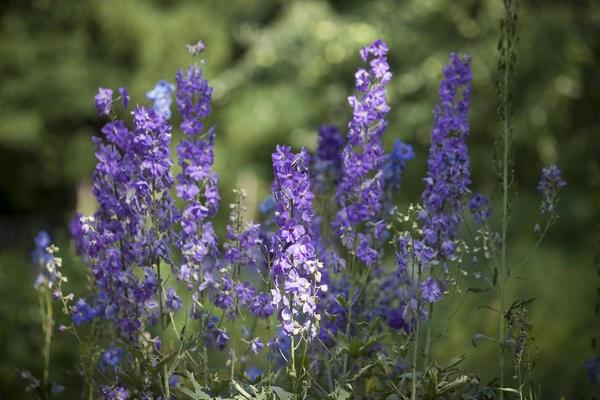

Saving by cuttings
If the chrysanthemums were purchased in late autumn and there is no way to arrange them for the winter in a suitable room, then you can leave the flowers in the apartment. However, there is no guarantee of their safety until spring (even with backlighting), so cuttings are used. Plants in pots are located on the windowsill closer to the window, away from the heating. Several cuttings (3-4 cm long) are plucked from the leaf sinuses. For their rooting, small cups filled with nutritious soil are prepared.
The planting technique is simple: a recess is made in the middle of the container, sand is poured into it, moistened, then the cutting is immersed (about 1 cm). The glass is tied with a plastic bag, but loosely so that ventilation remains. In such a greenhouse, a chrysanthemum stalk usually "sits" for 1-2 months, and then starts to grow. As soon as the roots become visible through the walls of the container or the first leaves appear, the shelter is removed. Buds may form, but they are removed immediately. Healthy planting material will be ready by spring.
Chrysanthemums amaze with their varietal variety, brightness, original forms. But many are afraid to grow them precisely because of the risk of freezing. Fortunately, keeping chrysanthemum bushes until next season is not difficult, even if there is no suitable space.
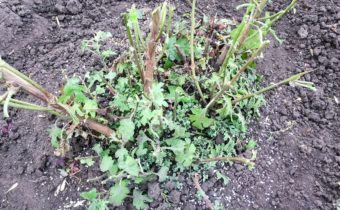

Garden perennial chrysanthemums are rightfully considered the decoration of the autumn garden. They add vibrant colors to the flower bed and fill the air with a tart scent when other plants finish blooming. Today we will talk about caring for chrysanthemums in the fall, preparing for winter.
Not all gardeners know that chrysanthemums need care no less than the capricious beauties of roses. What is the care of chrysanthemums in autumn, how to keep flowers in winter, is described in the article below.
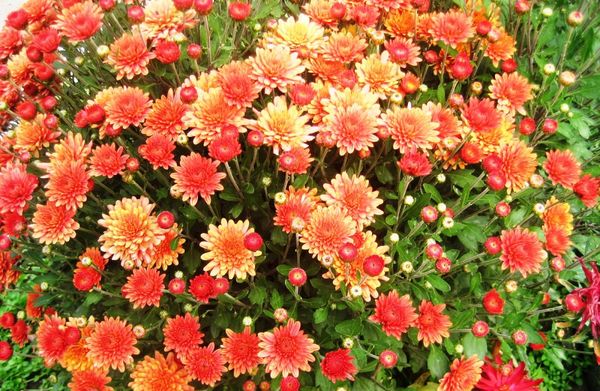

Work on the preparation of chrysanthemums for the winter period begins in September, when the plant still blooms profusely. In the southern regions, the deadlines for work are postponed to October, in the north, leaving begins in August.
Chrysanthemum care consists of:
- in fertilizing bushes with fertilizers;
- trimming the tops;
- treatment against diseases and pests;
- in the shelter of bushes for the winter or digging up plants for storage at positive temperatures.
How to transplant a flower correctly?
The procedure consists of several stages.
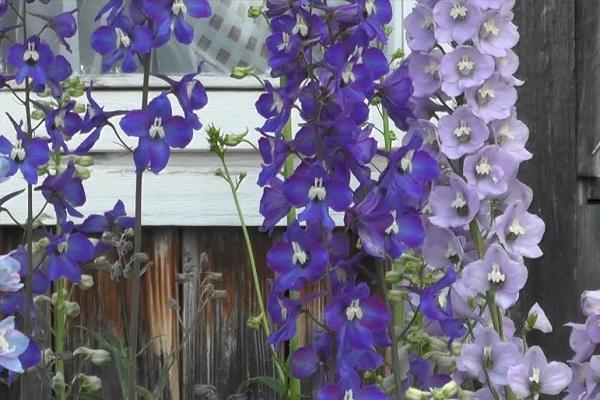

Seat selection
People often underestimate the importance of this point. What are the criteria:
- Delphinium is not planted near the passage of groundwater.
- The plot of land is protected from the wind.
- The place for the flower should be well lit by the sun's rays, and darkened at noon.
- Avoid places with stagnant moisture. If water is not absorbed into the soil, the roots will rot.
A correctly selected area contributes to the early flowering of the delphinium.
Soil preparation
The best soil for a plant is sandy loam or loamy. It must be enriched with organic matter. Slightly acidic or neutral soils are encouraged. Clay compounds are mixed with minerals and compost.
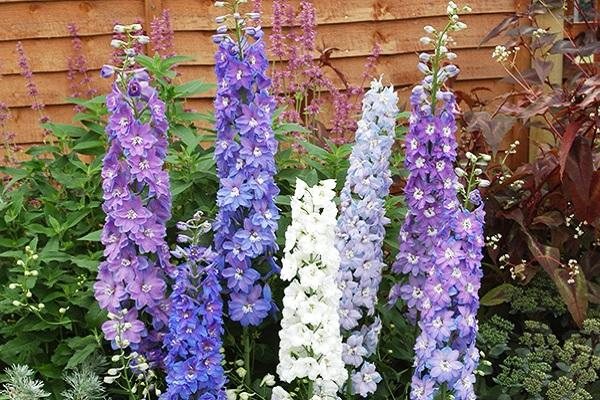

Transplant technology
The plant transfer procedure is as follows:
- A hole is formed, the depth of which does not exceed the bayonet of the shovel.
- Drainage is laid out at the bottom in a height of 15 cm.
- The soil from the pit is mixed with ash, compost and superphosphate.
- A small amount of earthen mixture is poured onto the sand from above.
- A plant is placed in the hole, spreading the roots.
See also
Description of the euphorbia flower, planting and care at homeRead
The rest of the soil is poured into the dug hole. During falling asleep, the delphinium holes are held so that it grows evenly. Similar techniques allow you to place a flower on a hill.
Winter storage rules
It is permissible to store the culture in different ways. It is worth choosing a specific method individually, taking into account climatic features.
In the trench
This method is suitable for regions where the soil does not freeze deeply and is covered with a good layer of snow. The depth of the trench should be between 0.5 and 1 meter. For this it is worth digging a narrow hole.
The bushes are recommended to be folded as tightly as possible. With a large number of plants, they are laid in 2 layers. The remaining space is filled with loose soil, sawdust, dry leaves. It is important to keep it dry inside as moisture is harmful to chrysanthemums. On top it is worth placing spruce branches, boards or slate. Then stretch the film and put leaves, soil or needles.
In the cellar on the floor
To preserve chrysanthemums, it is recommended to choose the right room. It must meet the following criteria:
- constant low temperature - from 0 to +4 degrees;
- good humidity;
- full ventilation;
- absence of fungal microorganisms, harmful insects, mold.
Chrysanthemum rhizomes are placed on the floor of the cellar or placed in a special box. It is recommended to pour 5-7 centimeters of earth into it. The bushes should be folded as tightly as possible and sprinkled with substrate.
During the winter, the rhizomes should be examined once a month. If they seem dry or sluggish, irrigate with water. When mold appears, the infected plants are taken out of the cellar, and the rest are treated with anti-fungal agents.
In a container
For plants, boxes or buckets are used. In this way, the culture is recommended to be stored on an insulated balcony, in a shed or basement. It is important that the temperature is within 0 ... + 5 degrees. The selected container should be filled with prepared soil. It is best to mix peat and coarse sand in equal parts.
In the greenhouse
Chrysanthemums are also perfectly stored in the greenhouse. For this, flowering bushes should be transplanted there in advance. This helps to increase the flowering period of crops. At constant negative temperatures and freezing of the stems, the plant should be cut off. As a result, it is recommended to leave hemp no more than 2-3 centimeters. From above, the bushes should be covered with humus.
So that the plants can survive the winter, each bush should be sprinkled with dry soil. Its height should be at least 20-25 centimeters. It is important that the soil is completely dry, as moisture is harmful to chrysanthemums in winter. Then it is recommended to insulate the planting with any covering material.
In a flowerpot
To store the chrysanthemum in a pot, it should be carefully dug up. The pot should be wide enough. A drainage layer should be laid on the bottom. For this purpose, gravel, crushed brick or expanded clay are suitable. Then it is recommended to place the plant in a container and fill it with a light and loose substrate.
Do I need to prune a delphinium for the winter?
The plant has high winter hardiness and is able to survive frosts from -40 to -45 degrees. Pruning is discarded if the plant hibernates under a thick layer of snow. In the conditions of modern winters in the Moscow region, rains more often "delight" residents than snowfalls.
In the cold season, gardeners are faced with two problems - damping and decay. Based on this, they conclude that the delphinium must be cut for the winter. Such a process should not be allowed to take its course.
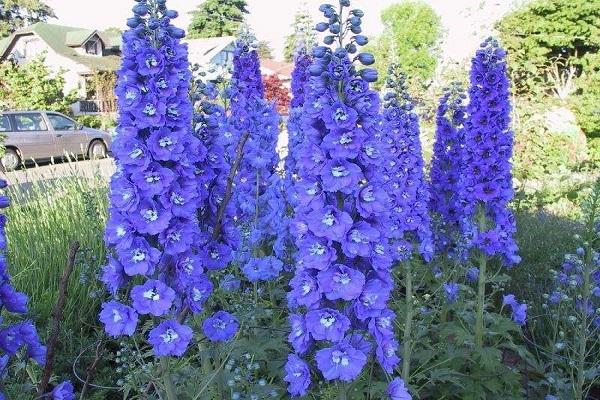

Organization of care at the stage of germination of seedlings
Since sowing is carried out at home, it is recommended to attach labels on containers indicating the sowing date, varietal accessory. Seeds are scattered on the soil in a container.
Sprinkle on top with a layer of 3 mm soil. Press down gently with your fingers to seal. With the help of a spray bottle, we moisten the future delphinium. We stretch the covering material.
But the correct planting does not give the full development of the plant. It is necessary to control the temperature regime, air humidity, carry out the necessary procedures for growth.
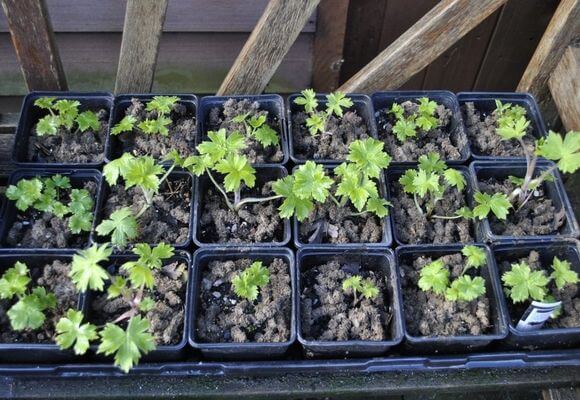

Temperature, humidity, illumination
After sowing, the delphinium should be kept in a dark place at a temperature not exceeding 15 degrees. After the appearance of green sprouts, move to the windowsill.
As a recommendation, farmers with experience are advised to send the plant to the bottom shelf of the refrigerator after 4-5 days. This will increase the germination rate.
After stratification (10-14 days), we put the containers on the windowsill. The covering film is removed. Now the delphinium needs a lot of light.
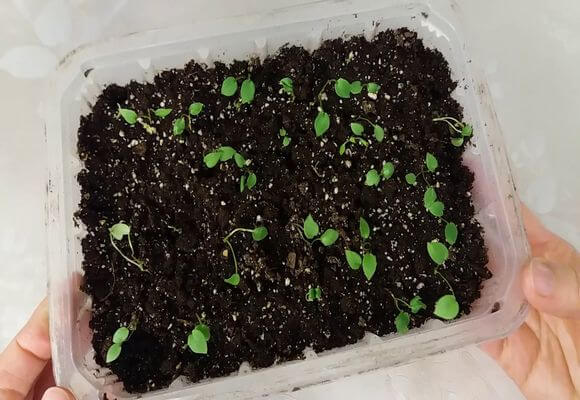

Watering and feeding
Moistening the soil is carried out as needed. A spray bottle is used. Drying out of the soil leads to the death of the seedling.
If the sowing of seeds was carried out in a purchased substrate, additional fertilizing is not required. When planted in an independent soil - after a pick, you can feed with complex preparations.
Picking
The picking process begins when there are 2-3 full-fledged leaves. The sprouts are planted in 200 ml containers. the air temperature rises to 20 degrees. Watering remains the same: irrigation.
Important! You can check how well the delphinium develops at home by the color of the leafy part. It should be dark green, pointed.
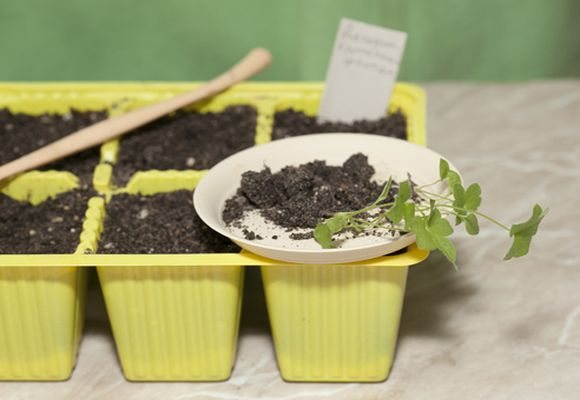

Little tricks
Take advantage of the advice of professional gardeners.
- Delphiniums love freedom. Make sure you plant them at least one step apart to avoid oversaturation of the area with plants.
- Dig up small drainage channels for the flowers. This will prevent over-watering and, as a result, the development of root rot.
You can find out some secrets about growing a delphinium in the following video.
Replacement
Dig up delphiniums carefully from the previous area. Gently separate the roots with your hands. Take the grafts and place them in a new location. Place 5-8 cm of soil on the roots and gently tap the ground with your hand to disperse air. Add a little more earth to the top of the root base and tap gently again to seal the base. After transplanting, you need a little water to strengthen the condition of the plants.
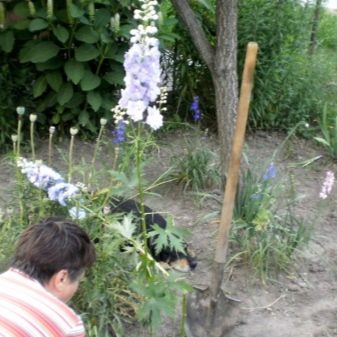

When spring comes, remove all but 2-3 of the strongest shoots. This will help stimulate growth later in the care of the plant.
You should also fertilize at this time. This process should be repeated in the summer and fall to stimulate the flowering of the plant next year.
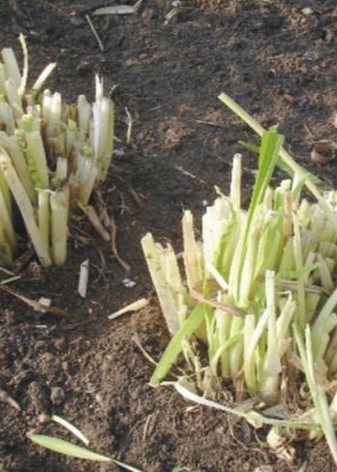

When is the best time to transplant?
Florists engaged in the cultivation of delphiniums do not have a consensus on this issue. Each variety has its own specific period.
In summer
Typically, the plant is transplanted in the spring or fall. But this can also be done in the summer season - in August. In this case, the delphinium should bloom. The transplant sequence is the same as in spring or autumn.
In autumn
Delphinium transplant is carried out in September. This time is good for plant propagation. The new site is being prepared according to all the rules.
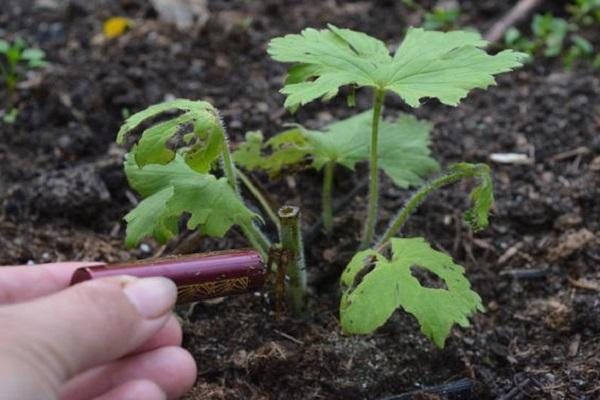

In the spring
Gardeners call this period the most suitable. The procedure is performed in early or mid-April. At the same time, they are waiting for the moment when the late frosts have completely passed. Reasons for transplanting a delphinium to a new location:
- rejuvenation of the bush;
- change of place, since the previous one turned out to be inappropriate;
- planting young shoots.
Florists are advised to pay attention to the autumn transplant. Before the onset of cold weather, the delphinium should develop a root system. Thus, he will endure frost without difficulty.
When to plant asters before winter?
It is correct to plant asters in the fall before winter like this:
- In October, it is necessary to prepare the bed in advance, cut the grooves and leave until the ground freezes.
- Seeds are lowered into the grooves on the frozen soil and they are covered by about 2 cm with pre-prepared humus or purchased soil (end of October - November).
If sowed earlier, before frost:
- Seeds will germinate in humid, relatively warm weather, and the sprouts will die in frost. You can see the weather forecast and sow asters about a week before frost. The seeds will fall into the ground, but not have time to germinate.
When frosts come, and the garden is not ready:
- If it was not possible to prepare the grooves in advance, there is already a stable minus on the thermometer, but the ground has not yet completely seized with frost, it is not too late to plant asters. The soil can be dug up, covered with ash and grooved.
The soil
Delphiniums usually enjoy nutrient-rich soil. Therefore, the quality of the soil in the new location should repeat the previous habitat. If you are not completely sure about the soil you are going to transplant, add compost or manure. Then the newly planted delphiniums will have a sufficient amount of nutrients.
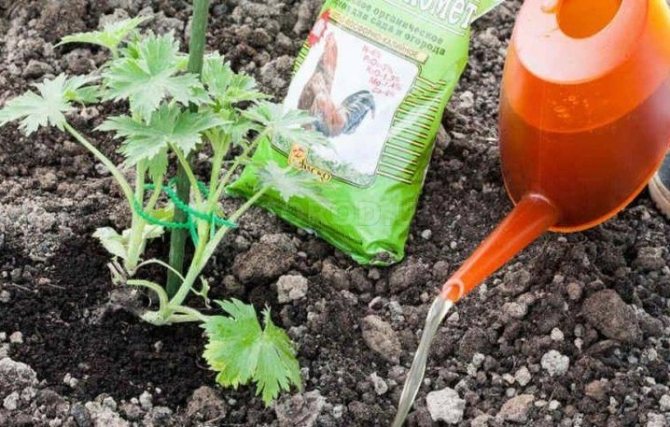

Delphiniums as part of landscape design
Well, now you know how to plant, grow and when to transplant delphinium. What role can this plant play in the design of the yard? On the site, delphiniums are always planted in groups. This makes the plant look much more spectacular. At the same time, it is worth growing varieties with inflorescences of different colors in the same flower bed. Very often it is delphiniums that are used as background plants in mixborders. At the same time, it is good to combine them with phlox, roses, lilies, dahlias. Sometimes delphiniums are planted at the front porch of a house or along its facade.



